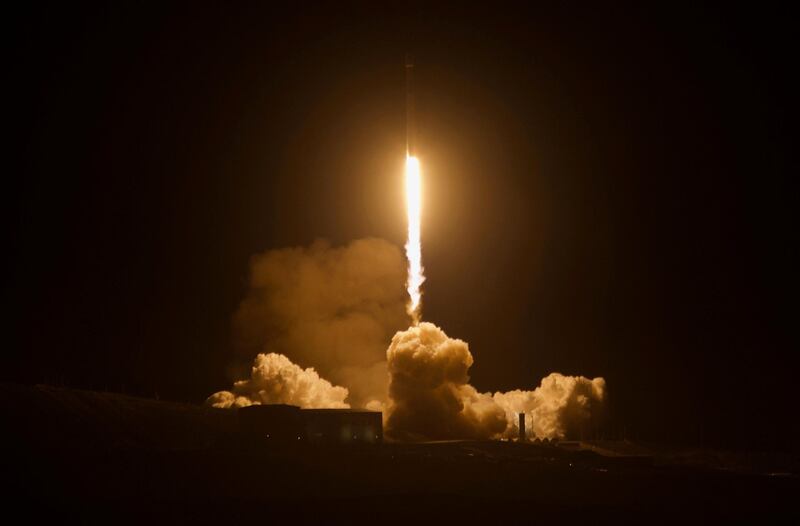When SpaceX launches its Falcon 9 rocket from Kennedy Space Centre in Florida on Friday it marks the start of a busy year for tech billionaire Elon Musk’s astronautics company.
It is the first of a series of scheduled lift-offs and another chance to test its reusable rocket technology.
But it is the payload that has excited and intrigued amateur satellite watchers around the world.
Almost nothing is known about the mission, code-named Zuma, other than that it involves a military contractor working for the US government.
And even that only came to light shortly before an aborted launch attempt last year, ramping up speculation that the cargo might be a secret spy satellite or even some type of weapons system.
Marco Langbroek, a Dutch academic who tracks satellites, said: “We know very little for sure about Zuma. We know it was built by Northrop Grumman, but it is not clear for which agency. Its history is peculiar too in that the launch — the original date set in November — was announced very late.”
That launch date had to be postponed when technicians feared a problem in the rocket fairing, the carbon fibre shell that protects the satellite during the rigours of lift-off.
On Wednesday, US Air Force weather forecasters identified a two-hour window on Friday evening, effectively giving the go-ahead for the countdown.
That is when the real guessing game will begin as space enthusiasts follow its course into a low earth orbit to try to work out its purpose.
Speculation began when regulatory filings for the flight appeared a month before its original November launch date — a short lead-in time for a business accustomed to years or at least months of pre-flight preparation.
Subsequent sleuthing revealed the satellite was operated by the American government. However, its National Reconnaissance Office, which is responsible for most surveillance satellites, says Zuma is not its project.
Northrup Grumman, a drone maker and military space contractor, confirmed it was behind the launch, but again left details vague.
“The Zuma payload is a restricted payload,” Lon Rains, the communications director for Northrop Grumman's space systems division, told Space.com at the time. “The event represents a cost-effective approach to space access for government missions.
“As a company, Northrop Grumman realises that this is a monumental responsibility and has taken great care to ensure the most affordable and lowest risk scenario for Zuma.”
Since then, amateur enthusiasts have pored over every available detail for clues, from the prosaic to the imaginative.
Some of the preparations are similar to another satellite launch, according to the website Spaceflight101, which concluded the rocket may follow a steeply lofted path, possibly indicating a light payload.
Discussion boards buzzed with theories that the hasty preparations suggested it was a time-sensitive mission, maybe geared to monitoring North Korea’s nuclear sites or some kind of response to reports that Russia had launched an anti-satellite weapon system into space.
Others have pored over a uniform patch designed for the mission. It includes a constellation of six stars in the top left, perhaps similar to a motif used by “black projects” at the world famous Area 51 test site in Nevada — the storage facility for alien remains if you believe the conspiracy theories.
Even the name of the mission offers no obvious clues. Is it a nod to Jacob Zuma, the president of Mr Musk's native South Africa? Or is it a reference to Zuma the chocolate Labrador pup in the children's cartoon Paw Patrol?
For now, the best minds have only been able to conclude that it may be a test bed for experimental technologies.
Dr Langbroek said the original November launch details appeared to mimic several of the features of USA 276, a satellite launched in May last year, which surprised star gazers by passing close by the International Space Station.
However, he said Friday’s launch window meant he had now ruled out a similar course for Zuma.
“Both Zuma and USA 276 are probably technology demonstrators, that is, experimental satellites to show some technology is feasible, and perhaps are part of the same programme (or competition - these are two spacecraft built by two different companies, perhaps in competition for a follow-up contract),” added Dr Langbroek, who details his findings on the SatTrackCam blog.
“But exactly how — and if — the two are related to each other remains murky. Maybe future orbital behaviour will shed some light on what Zuma is doing.”
Whatever its purpose, the launch will be another demonstration that Mr Musk’s company is making rapid progress.
Later this month it is due to test its massive Falcon Heavy rocket — with the power of three Falcon 9s — which is designed eventually to travel to Mars. Mr Musk recently announced that its first “passenger” will be his own cherry red Tesla Roadster electric car.






